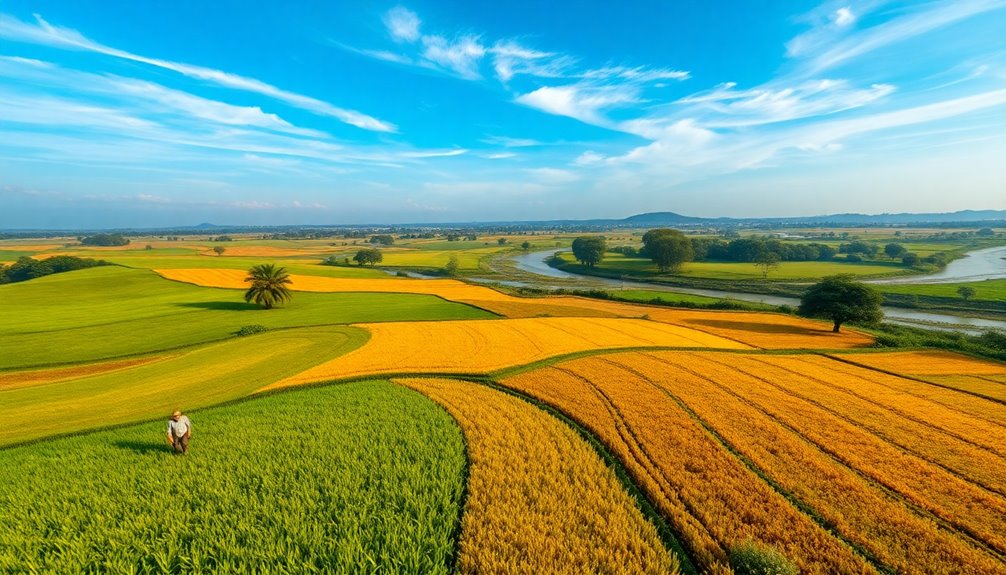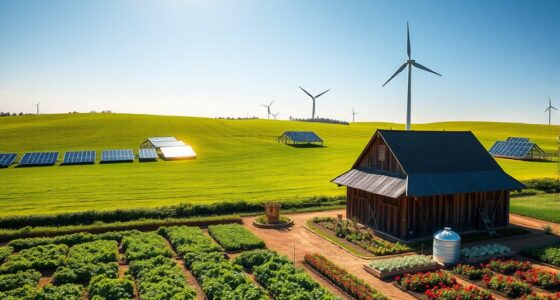Commercial agriculture is large-scale farming designed to meet market demands for profit. It focuses on maximizing efficiency using advanced technology and mechanization, with farms specializing in high-value crops or livestock. These operations play a key role in global supply chains, driving economic growth and food security. By investing heavily in resources and processes, commercial farms cater to consumer needs. If you're curious, there's more to uncover about its types, advantages, and future direction.
Key Takeaways
- Commercial agriculture refers to large-scale farming aimed at profit generation and meeting market demands.
- It specializes in specific crops or livestock to maximize efficiency and productivity.
- Investments in advanced technology and machinery are crucial for operational success.
- This type of agriculture plays a vital role in global supply chains and food security.
- It encompasses various farming types, including dairy, grain, livestock, and plantation farming.
Definition of Commercial Agriculture
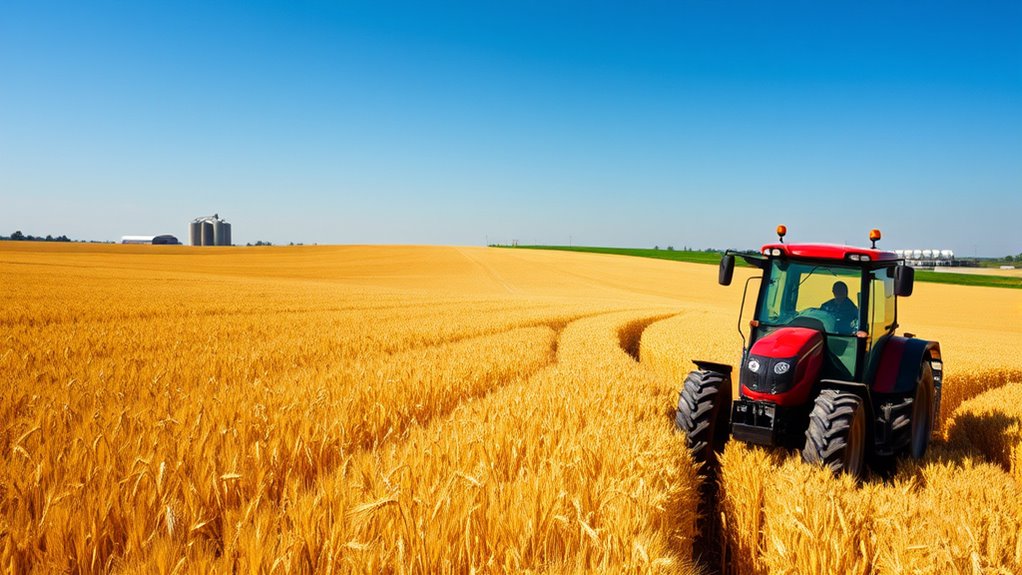
Commercial agriculture is defined as large-scale farming operations aimed at meeting market demands while generating profit.
Commercial agriculture encompasses extensive farming practices focused on profit while addressing market needs.
You'll find that commercial agriculture focuses on maximizing efficiency through the use of advanced technology and mechanization. These farms often specialize in specific crops or livestock, allowing them to benefit from economies of scale.
Capital-intensive by nature, they require significant investments in land, equipment, and inputs like seeds and fertilizers. Products are integrated into local, national, or international markets, making them a crucial part of global supply chains.
Whether it's crop-based systems like grain farming or livestock-based systems such as dairy farming, commercial agriculture plays a vital role in not just food production but also economic growth and employment opportunities.
Purpose of Commercial Agriculture
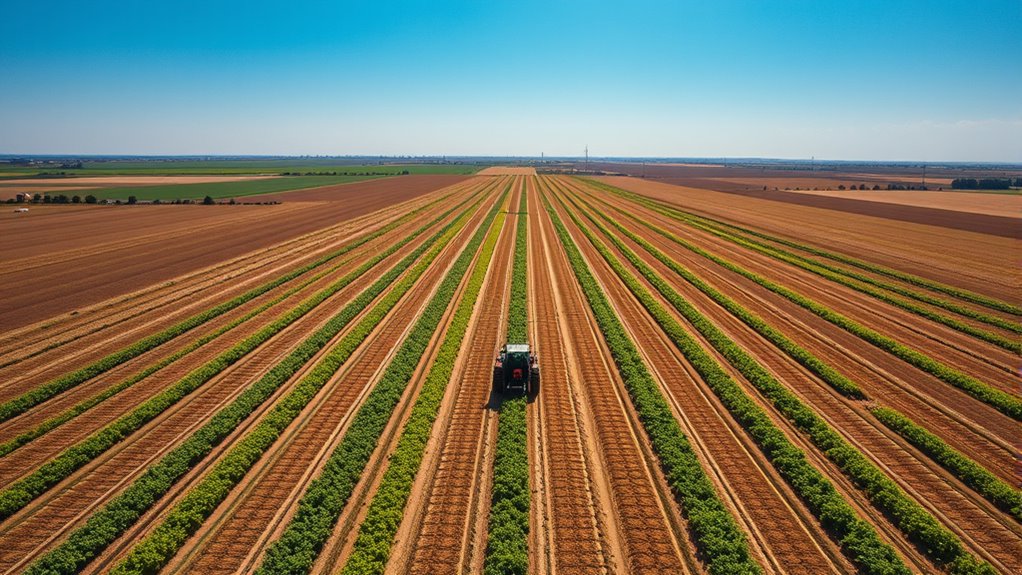
The primary purpose of commercial agriculture lies in its ability to meet the growing demands of consumers while driving economic growth. It significantly contributes to GDP and creates numerous employment opportunities, making it a vital sector in many economies.
By producing crops and livestock on a large scale, commercial agriculture fulfills market demand and maximizes profits through efficient, market-oriented strategies. This sector also plays a crucial role in ensuring food security, providing a substantial portion of the global food supply.
Additionally, commercial farming facilitates international trade by exporting and importing agricultural products. With advanced technology and specialized production methods, it adapts to market trends, ensuring that diverse food products are consistently available for consumers worldwide.
Types of Commercial Agriculture

Various types of commercial agriculture cater to different market needs and environmental conditions, each playing a unique role in the agricultural landscape.
Dairy farming focuses on producing milk and related products, while livestock ranching raises animals for meat. Grain farming cultivates staples like wheat and rice on a large scale, and plantation farming specializes in cash crops such as coffee and cocoa.
Mixed crop and livestock farming combines both approaches for efficiency. Additionally, commercial gardening and fruit farming produce high-demand fruits and vegetables.
Mixed crop and livestock farming enhances efficiency, while commercial gardening and fruit farming meet the growing demand for fresh produce.
Mediterranean agriculture thrives in specific climates, emphasizing unique crops. Each type of commercial agriculture not only meets consumer demands but also adapts to regional characteristics and technological advancements, ensuring sustainability and profitability in the industry.
Features of Commercial Farms
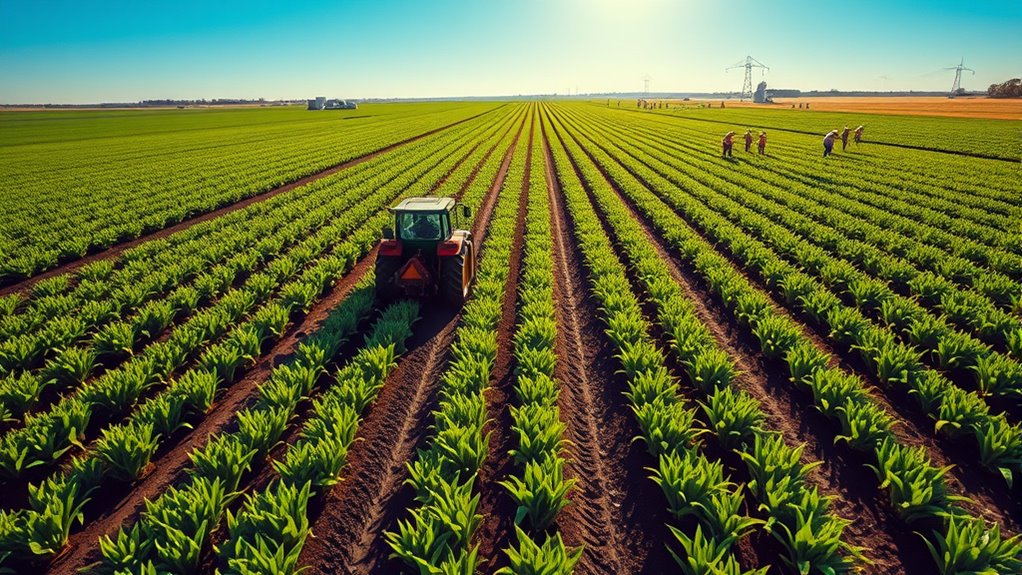
Farms in the commercial sector are characterized by their large-scale operations and focus on profitability.
You'll notice that these farms operate on vast lands to produce high volumes of crops and raw materials for industries. Significant investments in machinery and advanced technology, like precision farming, enhance their productivity and efficiency.
Specialization is key; farmers often choose high-value crops to meet market demand. Moreover, commercial farms integrate into global supply chains, exporting their products internationally.
They utilize high-yielding varieties and mechanization for efficiency, while reliable irrigation systems support consistent production. Practices like crop rotation ensure soil health, promoting long-term sustainability.
Advantages of Commercial Agriculture
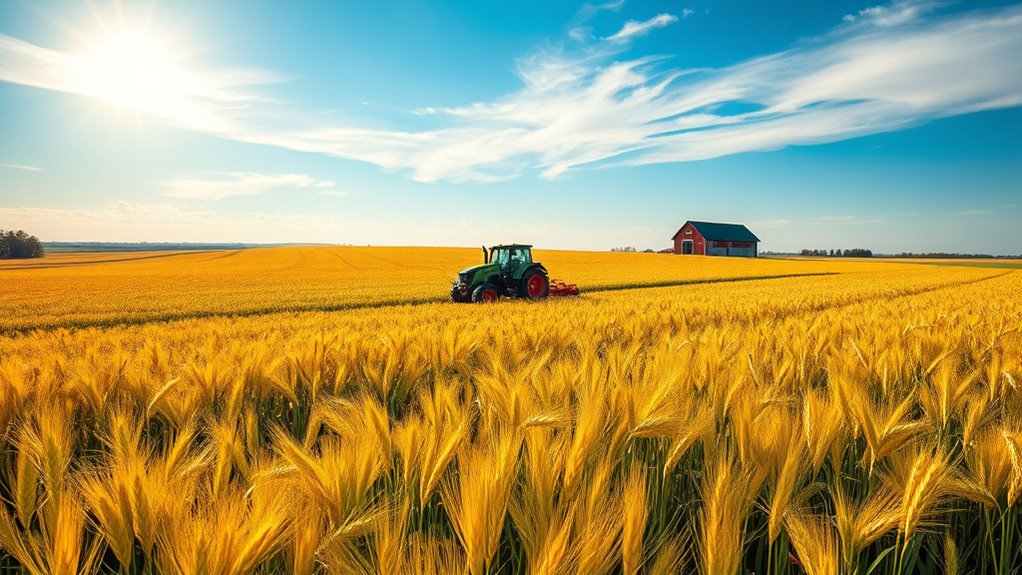
While you may consider the challenges of food production, the advantages of commercial agriculture are substantial and far-reaching.
It significantly boosts food security by producing large quantities of crops and livestock, ensuring a diverse food supply that meets various nutritional needs. You'll find products readily available in local and international markets, which helps stabilize food prices and reduce hunger.
Economically, it creates numerous job opportunities and allows farmers to generate higher incomes, contributing to overall economic growth.
With investments in modern technology, commercial agriculture enhances productivity through precision farming and mechanization.
Additionally, it opens up export opportunities, earning foreign exchange and boosting national economies, making it a vital component of today's agricultural landscape.
Challenges in Commercial Agriculture
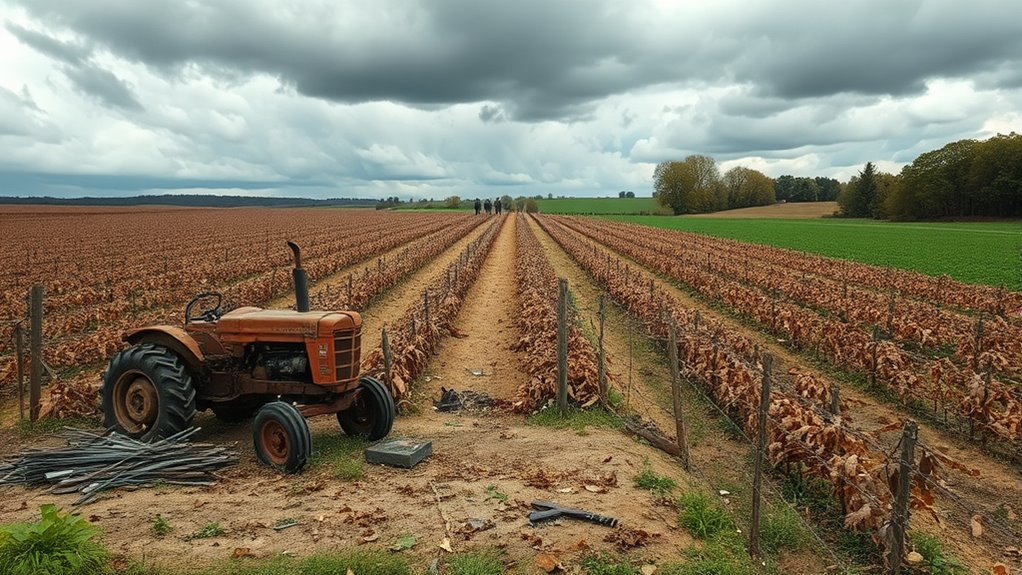
Despite the numerous advantages that commercial agriculture offers, it faces significant challenges that can undermine its effectiveness. Climate change disrupts your crop production with unpredictable weather, leading to decreased yields.
Commercial agriculture, while beneficial, grapples with major challenges like climate change and unpredictable weather, threatening crop yields.
Soil degradation from intensive practices diminishes long-term productivity, while water scarcity limits irrigation, affecting plant growth and yield quality. Additionally, rising input costs strain your profitability, and labor shortages make it tough to manage operations efficiently.
You also contend with global competition and fluctuating market prices, complicating your planning. Regulatory requirements add complexity, and the need for technology adoption can be costly.
Navigating these challenges requires adaptability and strategic planning to maintain your agricultural success in a competitive landscape.
Environmental Impact of Commercial Agriculture

Commercial agriculture, often touted for its efficiency and productivity, significantly impacts the environment in various detrimental ways.
You'll notice that deforestation for crop expansion leads to habitat loss and biodiversity decline. Overusing chemical fertilizers and pesticides can degrade soil quality and reduce its fertility.
Additionally, fertilizer runoff pollutes water sources, causing harmful algal blooms and oxygen depletion. This practice also contributes to climate change, as agriculture is a major source of greenhouse gas emissions.
Moreover, the reliance on irrigation often results in water scarcity and groundwater depletion.
You should be aware that these practices not only harm ecosystems but also threaten long-term agricultural sustainability, highlighting the urgent need for more environmentally friendly approaches.
Technological Innovations in Agriculture
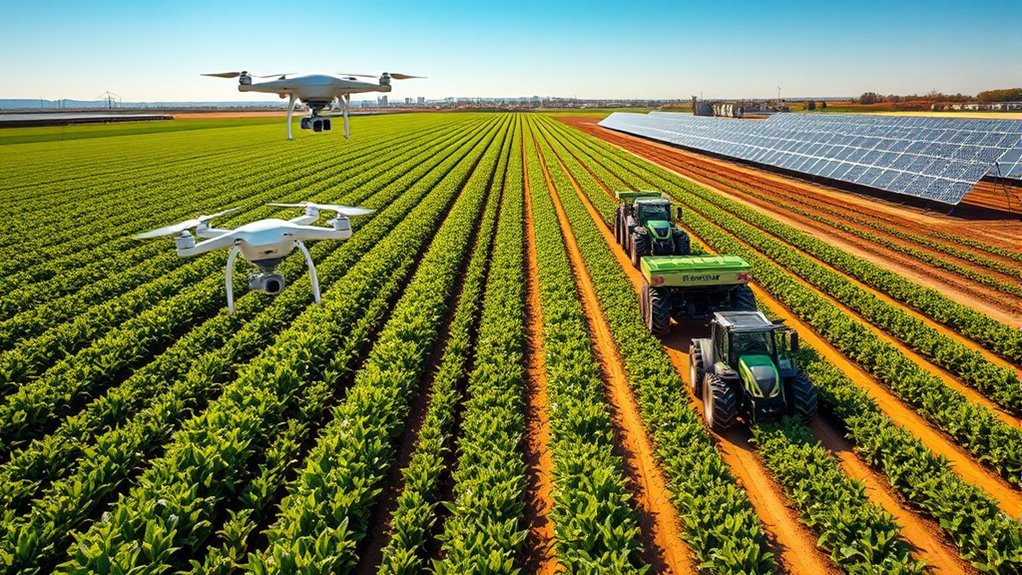
As technology advances, agriculture is experiencing a transformative shift that enhances efficiency and sustainability.
You'll find drones and autonomous machinery revolutionizing crop monitoring and harvesting, cutting labor costs while boosting productivity.
Smart farm equipment equipped with sensors and AI provides real-time data, allowing you to make informed decisions on irrigation and fertilization.
Precision farming techniques, like GPS-guided tractors and soil sensors, optimize resource use, reducing waste significantly.
Water management is also improving through drip irrigation and smart systems that adjust usage based on soil moisture.
Genetic engineering and CRISPR technology are enhancing crops for better yields, pest resistance, and resilience to climate challenges.
Embracing these innovations enables you to cultivate smarter and more sustainably. Additionally, advancements in color accuracy are vital for improving crop monitoring through better imaging technologies.
Sustainability in Commercial Farming
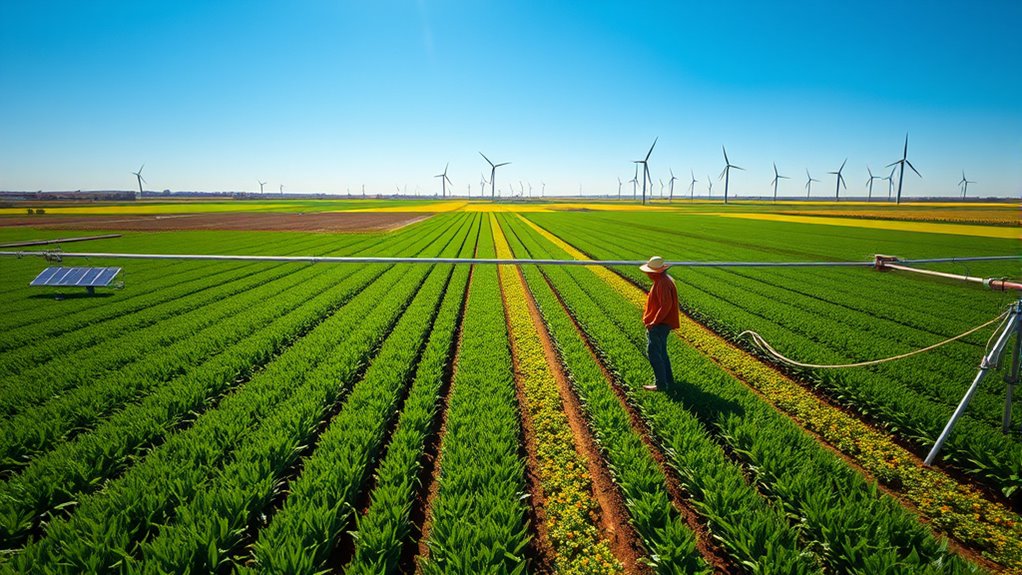
Sustainable practices in farming are crucial for ensuring the long-term health of our planet and its resources. By adopting methods like agroforestry and polyculture farming, you can enhance biodiversity and reduce deforestation. Integrating practices like crop rotation can significantly improve soil health, making your farm more resilient. Additionally, utilizing renewable energy sources can further reduce your farm's carbon footprint and promote sustainability.
Crop rotation and cover crops help maintain soil fertility and prevent erosion, while integrated pest management offers sustainable pest control solutions. These practices not only contribute to environmental health but also support economic sustainability. They help you tap into new market opportunities and promote local food systems.
Prioritizing fair labor practices and community engagement ensures social responsibility, fostering rural development and food security. Additionally, incorporating stress management techniques can improve overall farm productivity and worker well-being.
Future Directions for Commercial Agriculture
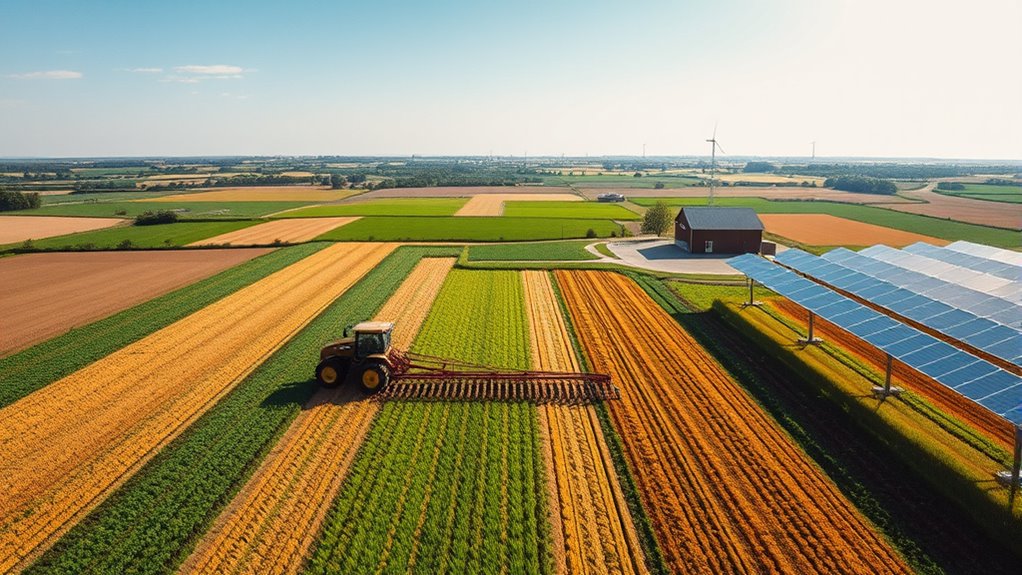
While navigating the evolving landscape of agriculture, you'll find that the future of farming hinges on integrating advanced technologies and innovative practices.
Cloud computing, precision agriculture, and AI are revolutionizing your operations, enabling efficient resource management and better decision-making. Drones and IoT devices enhance monitoring and operational efficiency, while big data analytics helps predict challenges.
Advanced technologies like cloud computing, precision agriculture, and AI are transforming farming, optimizing resource management and enhancing decision-making processes.
As you adapt to market demands, consider specializing in high-value crops and utilizing vertical farming techniques in urban areas. Climate change poses challenges, but investing in climate-resilient crops and sustainable practices will be essential.
Embracing these advancements not only boosts productivity but also aligns with consumer preferences for sustainability and ethical sourcing, ensuring your competitive edge in the global market.
Frequently Asked Questions
How Does Commercial Agriculture Differ From Subsistence Farming?
Commercial agriculture differs from subsistence farming mainly in scale and purpose.
You'll find that commercial farms are larger and focused on producing crops or livestock for sale, aiming for profit.
In contrast, subsistence farming is about growing food primarily for personal consumption.
Additionally, commercial agriculture employs advanced technology and mechanization, while subsistence farming relies more on traditional methods.
What Role Do Government Policies Play in Commercial Agriculture?
Government policies significantly influence your commercial agriculture practices. They provide crop subsidies that help stabilize your income and guide your planting choices.
Price controls can affect your earnings, while land use policies determine how you manage your land.
Additionally, environmental regulations shape your farming methods to protect ecosystems.
Access to research funding can boost your productivity and innovation, ensuring you stay competitive in an ever-changing market.
How Can Small Farms Compete With Large Commercial Operations?
To compete with large commercial operations, you can focus on niche markets that cater to specific consumer needs.
Engaging in local sales helps reduce costs and build community support.
Diversifying your product offerings attracts a broader customer base.
Adopting technology where possible boosts efficiency, and collaborating with other small farms allows you to share resources and knowledge.
What Are the Labor Conditions in Commercial Agriculture?
Labor conditions in commercial agriculture can be harsh.
You'll find many farm workers excluded from federal protections, making it tough for them to secure fair wages or unionize. The work is physically demanding and often dangerous, with risks like pesticide exposure and heat stress.
Access to basic necessities is limited, and enforcement of existing labor laws is inconsistent. As a result, many workers struggle with poverty and unsafe working conditions.
How Does Climate Change Affect Commercial Farming Practices?
When it comes to farming, you might say the weather's become a bit unpredictable lately.
Climate change shakes up your practices significantly. Rising temperatures can scorch your crops, and erratic rainfall might leave you scrambling for water.
Pests and diseases are on the move, making your job even trickier. To stay ahead, you'll need to embrace sustainable methods and innovative technologies that can help you adapt and thrive despite these challenges.
Conclusion
In the ever-evolving world of commercial agriculture, it's amazing how your choices at the grocery store can ripple back to the farms. By understanding the purpose, benefits, and challenges of commercial farming, you're not just a consumer; you're part of a bigger picture. As technology and sustainability shape the future, you have the power to influence these practices with every meal you enjoy. So, next time you shop, think about the farms behind your food!





